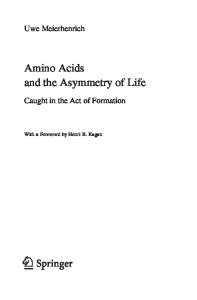Stereochemistry of silicon in oxygen-containing compounds
- PDF / 882,627 Bytes
- 10 Pages / 612 x 792 pts (letter) Page_size
- 4 Downloads / 496 Views
TAL CHEMISTRY
Stereochemistry of Silicon in Oxygen-Containing Compounds V. N. Serezhkina,* and V. S. Urusovb† a Samara
b
National Research University, Samara, 443086 Russia Faculty of Geology, Moscow State University, Moscow, 119992 Russia *e-mail: [email protected] Received September 30, 2015
Abstract—Specific stereochemical features of silicon in oxygen-containing compounds, including hybrid silicates with all oxygen atoms of SiOn groups (n = 4, 5, or 6) entering into the composition of organic anions or molecules, are described by characteristics of Voronoi—Dirichlet polyhedra. It is found that in rutile-like stishovite and post-stishovite phases with the structures similar to those of СаСl2, α-PbO2, or pyrite FeS2, the volume of Voronoi—Dirichlet polyhedra of silicon and oxygen atoms decreases linearly with pressure increasing to 268 GPa. Based on these results, the possibility of formation of new post-stishovite phases is shown, namely, the fluorite-like structure (transition predicted at ~400 GPa) and a body-centered cubic lattice with statistical arrangement of silicon and oxygen atoms (~900 GPa). DOI: 10.1134/S1063774517010229
Earth by formation of post-perovskite (Mg, Fe)SiO3 [5–7] in which SiO6 octahedra share vertices to form corrugated SiO6/2 = SiO3 layers. This study is performed with the aim to analyze specific stereochemical features of silicon in oxygen-containing compounds (including those with organic ligands) based on the stereoatomic model of the structure of crystalline substances (SMSC) [8, 9].
INTRODUCTION Within 90 years that passed since the structure of crystals containing silicon atoms in oxygen environment (β-cristobalite [1] and α- and β-quartz [2]) was determined, structures of more than twenty thousand oxygen-containing compounds of silicon have been studied. These compounds (hereinafter, all of them are for brevity called silicates) attract considerable interest, since many of them are known as various minerals entering into the composition of rocks which form the main part of the Earth’s crust. Several generations of scientists took part in investigations of composition and structure of silicates; many of them (W. Bragg, L. Pauling, N. Belov, F. Liebau, and others) have made a significant contribution to the development of crystal chemistry and mineralogy [3]. It was thought for a long time that in all silicates silicon atoms have coordination number (c.n.) four and form tetrahedral SiO4 groups. It was not until 1961 that the new modification of silicon dioxide (stishovite) with silicon atoms having c.n. = 6 and forming the SiO6/3 = SiO2 framework was obtained at high pressure [4]. First compounds containing hypercoordinate silicon atoms in SiO6 octahedra obtained under standard conditions using oxygen-containing organic ligands were also studied at the end of this decade. Effect of pressure and temperature on specific structural features of silicates have been actively studied in recent years, in particular, in the context of attempts to explain some seismological features of
Data Loading...



